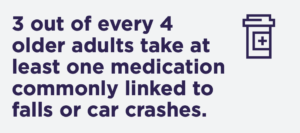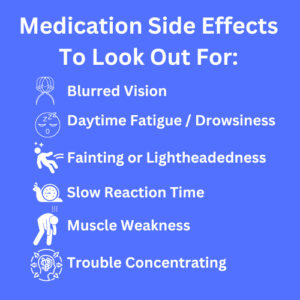
Falls pose a significant threat to the health and independence of older adults, and understanding the relationship between medications and fall risk can help mitigate this danger.
As we age, our bodies undergo various changes, and while medications are often necessary to manage health conditions, it’s essential to recognize that some can increase the risk of falls, particularly among seniors.
These advantages make balance training an indispensable part of a senior’s health routine. It’s not just about preventing falls; it’s about enhancing overall physical function, promoting independence, and improving the quality of life.
 The Link Betwee Medications & Falls
The Link Betwee Medications & Falls
Medications can play a crucial role in managing chronic conditions, alleviating symptoms, and improving overall health and well-being. However, certain types of medications, particularly those that affect the central nervous system, can disrupt balance, coordination, and cognitive function, thereby increasing the risk of falls among older adults.
Common classes of medications that increase the likelihood of falls:

It’s important to note that individual responses to medications can vary, and certain factors such as age, overall health, and medication interactions can influence how a person reacts to a particular drug. Therefore, it’s crucial to discuss medication regimens with healthcare providers regularly and report any side effects or concerns.
To determine if medications are contributing to an individual’s fall risk, it’s essential to consider several factors (for more on medication and fall risk, review the CDC’s Medication Medicine Fact Sheet:
Polypharmacy: Those who take multiple medications (polypharmacy) are at a higher risk of experiencing adverse drug reactions and interactions. Older adults are more likely to take multiple medications. Taking five or more medications further increases the chances of side effects.

Changes in Medication: Any changes in medication dosage, type, or frequency should be closely monitored for potential side effects or adverse reactions.
Concurrent Health Conditions: Certain health conditions, such as dementia, Parkinson’s disease, or cardiovascular disorders, may increase sensitivity to medication side effects and elevate fall risk.
Environmental Factors: Consider how medications may interact with environmental factors such as poor lighting, uneven surfaces, or obstacles in the home.
While medications can contribute to fall risk, there are proactive steps that seniors can take to reduce their susceptibility to falls. Strength & Balance training exercises can play a meaningful role in improving stability, coordination, and muscle strength, thereby enhancing overall balance and reducing the likelihood of falls.
Medications play a vital role in managing health conditions and improving the quality of life for seniors. However, certain medications can increase the risk of falls due to their effects on balance, coordination, and cognitive function. By identifying medication-related fall risk factors and incorporating balance training and exercises into their routine, older adults can take proactive steps to reduce their susceptibility to falls and maintain their independence and well-being.
Remember to consult with your primary care physician or pharmacist before making any changes to your medication regimen, and prioritize safety and fall prevention in your daily life. With awareness, education, and proactive measures, seniors can minimize their risk of falls and enjoy a healthier, more active lifestyle.